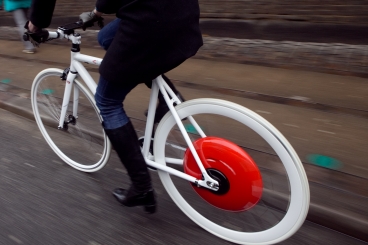MIT updates bicycling with Copenhagen Wheel


The hub is laced with sensors that speak to a handlebar-mounted smart phone via Bluetooth. It can keep track of direction and distance traveled, provide stats on smog and traffic levels in the rider's vicinity, the proximity of friends, and personal fitness.
But that's not all. The wheel can store energy every time the rider puts on the brakes, and then give that power back to provide a boost when riding uphill or to add a burst of speed in traffic.
According to Carlo Ratti, director of the MIT SENSEable City Laboratory and the Copenhagen Wheel project, the wheel uses a technology similar to the KERS (Kinetic Energy Recovery System) now commonly used in Formula One racing.
"When you brake, your kinetic energy is recuperated by an electric motor and then stored by batteries within the wheel, so that you can have it back to you when you need it. The bike wheel contains all you need so that no sensors or additional electronics need to be added to the frame and an existing bike can be retrofitted with the blink of an eye," Ratti said.
The initial prototypes of the Copenhagen Wheel were developed along with company Ducati Energia and the Italian Ministry of the Environment.
It is expected that the wheel will go into production next year, with a tag price competitive with that of a standard electric bike.
Additional reading: Interview with Andrea Vaccari, research associate at MIT's SENSEable City Laboratory